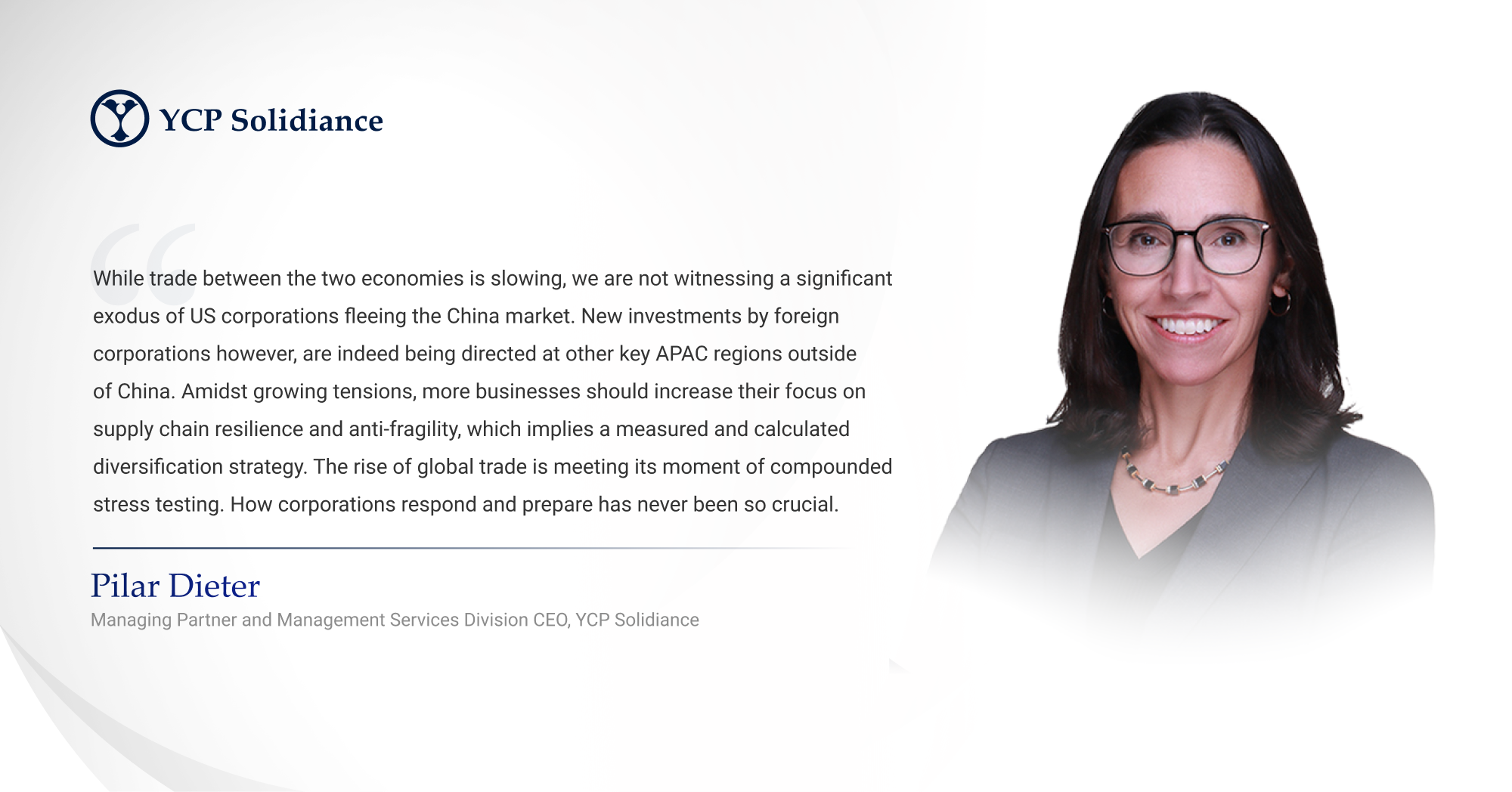Author
Pilar Dieter
Pilar is YCP Solidiance's California office Managing Partner and experienced advisor with Fortune 500 firms seeking growth opportunities in Asia.
The United States and China are the two largest economies in the world with a long and complex history of business and trade. In 2011, China overtook the US to become the largest producer of manufactured goods, signaling a change in the way that both markets would interact in the years to come. As of 2024, both nations are navigating a delicate balance between economic interdependence and geopolitical rivalry.
We spoke to Pilar Dieter, Managing Partner and the CEO of YCP’s Management Solutions Division, to share her insights on how US-China business relations have transformed. Having previously spent over a decade in Shanghai helping international businesses enter the Chinese market, Pilar is well-versed in the field and brings with her a unique perspective on navigating the complexities of cross-border trade and investment between these two economic giants.
What attracted major markets, such as the US, to manufacture their goods in China?
China first positioned itself as a manufacturing hub in the late 1970s and the early 1980s, following the country’s economic reform. Over the course of three decades, China was able to develop its manufacturing industry into the powerhouse that it is by focusing on four key aspects:
Access to talent – The sheer population of China's economy proved that it would have a labor force that could accommodate the business and trade coming in from other markets. Workers were also skilled and well-trained in general manufacturing activities, whether in oil, gas, chemicals, or apparel.
Cost arbitrage – Low labor costs made China an attractive option for many businesses looking to cut down on expenses. This cost advantage has historically drawn significant foreign investment, further strengthening China's position as a global manufacturing hub.
Robust infrastructure system – With hundreds of airports and state-of-the-art ocean terminals rapidly put into place, China positioned themselves as a competitive port for global trade. The combination of government-backed domestic infrastructure investment, tremendous speed at building out the nascent infrastructure at “China speed,” and the ambition to become the world’s gateway to Asia, China masterfully established logistics capabilities necessary to enable global trade to come in and out of their shores.
Centralized government system – The Chinese government introduced manufacturing incentives that drove economic capabilities in the sectors that mattered the most, allowing them to strengthen their manufacturing capabilities and rapidly ascend the production ladder from toys and tables to computer chips and EV power storage technologies.
In recent years, there has been talk about the declining trade between the US and China. What has changed and why?
Despite recording an all-time high in bilateral trade in 2022, trade between both powerhouses remains contentious, with ongoing tariffs, technological restrictions, and geopolitical tensions shaping their economic interactions.
Geopolitical tensions – Geopolitical tensions continue to rise between the two economies, affecting overall trade. US businesses are now more vocal about seeking investment opportunities in other markets and limiting investments to China, citing the need to “de-risk.” Recently, the US also tightened export controls to restrict China’s access to semiconductors, including the materials and equipment needed to create the technology, further escalating tensions between the two countries.
Structural Instability – China now faces the challenge of overcapacity in production across various sectors, such as clothing, and renewable energy, with excess supply in electric vehicles, solar panels, batteries, and more.
Labor shortage/aging population – At present, China has an aging population that cannot be supported by the rising middle class. While its retiring population continues to grow, their general population has seen a decline over the last two years. Various factors, such as the increasing cost of living and health concerns, have contributed to lower birth rates, exacerbating the demographic challenges facing the country.

While trade between the two economies is not expected to decline dramatically, it is likely that the US and other markets will continue to explore other investment opportunities across the APAC region. Countries such as Vietnam, Indonesia, and India are becoming increasingly attractive alternatives as manufacturing and investment destinations due to their favorable economic policies and growing labor markets.
Amidst growing tensions, more businesses should increase their focus on supply chain resilience and anti-fragility. With the different challenges that ensue with global trade, employing a more diversified supply chain model helps businesses mold to these challenges when they arise without collapsing.
At YCP, we consistently observe how businesses are adapting to the dynamics between these two economies. Increasingly, companies are seeking our advice on how to make their operations resilient to potential disruptions. Our role is to provide expert counsel, guidance, and mitigation planning services to help them become resilient in an increasingly unpredictable world where global trade will remain.
Pilar is our Managing Partner based in the USA, and the CEO of the Management Services Division with over 250 professionals. Pilar is an experienced advisor with clients from Fortune 500 firms seeking growth opportunities in Asia. Pilar has been involved across a number of foreign and American business interests in China across various government and private entities focused on cross-border trade. Pilar has a strong Asian market knowledge and has worked in Singapore, Japan, Korea, China, India, and Malaysia. Prior to joining YCP Holdings, Pilar worked for an advisory growth strategy firm where she managed professional services and product management divisions in Silicon Valley. She has also served as the Board Member of the American Chamber of Commerce in Shanghai. Pilar has been with YCP Solidiance since 2011.
Access our other insights below:






